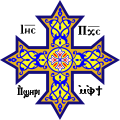Priesthood
He was ordained as a priest at the age of eighteen. At which time he left for the St. Anthony's monastery then to Palestine, and worked in construction. Upon hearing of the persecution of Copts because of the actions of the Crusaders, he returned to St. Anthony's Monastery. at that time he was appointed abbot of the monastery.
Shortly after his ordination, Prince Yalpogha led the monks and their abbot in humility through the streets of Cairo in an attempt to convince the prince and the authorities that the Crusaders' actions were unconnected to the Copts. The Crusaders' sack of Alexandria roused the ruling prince and his men against the local Christians (including) Copts. [1] Afterwards, Matthew left for Al-Muharraq monastery. Matthew was also a monk at the Monastery of Saint Fana.
Coptic Pope
On the death of Gabriel IV Patriarch of Alexandria (1378), Father Matheos was elected be the next patriarch, he solicited the council of the elders of St. Anthony's monastery, and accepted their decision. Escorted to Alexandria, he was consecrated as Pope, and gave himself the title El Meskin ("The Poor").
Pope Matthew was known for his charitable work with the poor.
Relations with ruler
Through his cordial relation with Sultan Barquq, he was able to stop the mob from burning Al-Muallaqa church and the Shahran monastery, because the Muslims were claiming that new constructions were taking place in those two locations. The Sultan appointed four Judges of Islam who declared the falsehood of such claims.
The situation worsened when two Mamlur princes exiled Sultan Barquq, and took his place. Mentach and Yalpogha persecuted the Copts and their Pope.
One of the Mamluks, by the name Gamal-El-Din, also persecuted the Christians. He imposed a tribute of five hundred thousand dinars.
This page is based on this
Wikipedia article Text is available under the
CC BY-SA 4.0 license; additional terms may apply.
Images, videos and audio are available under their respective licenses.
